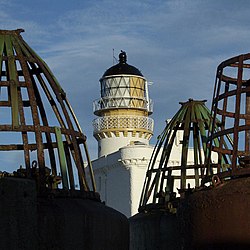Kinnaird Head Lighthouse
| Kinnaird Head Lighthouse | |
 Kinnaird Head Old Lighthouse | |
|---|---|
| Location | |
| Grid reference: | NJ99846757 |
| Location: | 57°41’53"N, 2°0’16"W |
| Characteristics | |
| Height: | 33 feet |
| Tower shape: | cylindrical tower with balcony and lantern |
| Tower marking: | White |
| Light: | F. W 5s. |
| Intensity: | 690,000 candela |
| Focal height: | 82 feet |
| Range: | 22 nautical miles |
| Admiralty No.: | A3332 |
| History | |
| Built 1824 | |
| Information | |
| Owned by: | Northern Lighthouse Board |
The Kinnaird Head Lighthouse is an active lighthouse located on Kinnaird Head, by Fraserburgh in Aberdeenshire. The current light is the second to be built on the headland, superseding the original which now forms part of the Museum of Scottish Lighthouses.
History
The original light at Kinnaird Head Lighthouse was established by Thomas Smith on 1 December 1787.[1] A lantern was set 120 feet above the sea on a tower of the old castle. Whale oil lamps produced a fixed light, each backed by a parabolic reflector.
Kinnaird Head was the most powerful light of its time, and contained 17 reflectors arranged in 3 horizontal tiers. It was reported to be visible from 12 to 14 miles off. The first lighthouse keeper was James Park, who was paid a shilling per night and remained in the job for nearly a decade.[2]

In 1824, internal alternations were made to construct a new lighthouse tower through the original castle tower. This tower supported a new lantern and reflector array by Robert Stevenson.
In 1851 Robert's son, Alan Stevenson, installed a first order dioptric lens at Kinnaird Head. The lens was standing and gave a fixed character. The site was further improved in 1853 with the site's first purpose built accommodation blocks designed by brothers David and Thomas Stevenson.
David Alan Stevenson further upgraded the site in 1902 by installing a flashing lens apparatus. The rare hyperradial fresnel lens gave one flash every fifteen seconds and was visible for 25–27 miles. The lens was designed by David and his brother Charles Alexander Stevenson, and was made by the Chance Brothers: Hyskeir and Kinnaird Head are the only stations today to retain their complete hyperradials. A foghorn was also built and was operational from 1903 giving a 7-second blast every 90 seconds.
In 1906 the light was converted to incandescent operation. In 1929 a radio beacon was established at Kinnaird Head: the first radio beacon in the north.[1] The Fog Signal was discontinued in 1987, although the horn is still in place. The original lighthouse is no longer operational and is now home to The Museum of Scottish Lighthouses. A new automatic light was established beside the original light in 1991.
In 2012 the Old Kinnaird Head Lighthouse was lit for two anniversary celebrations. First, on 2 June 2012 the light was exhibited in celebration of the Queen's Diamond Jubilee. This coincided with the lighting of the Board's Queen's Diamond Jubilee Beacon at Kinnaird Head Lighthouse. Secondly, the light was exhibited on 1 December 2012 in celebration of Kinnaird Head's 225th anniversary. The light was lit at 3.31pm, and extinguished at 8.30am the next morning, marking a full 17-hour shift. On that occasion Kinnaird Head was the only manned lighthouse in the British Isles, albeit outwith Northern Lighthouse Board service. Both events were organised by the Museum of Scottish Lighthouses.
Outside links
| ("Wikimedia Commons" has material about Kinnaird Head Lighthouse) |
References
- ↑ 1.0 1.1 "Kinnaird Head". Northern Lighthouse Board. http://www.nlb.org.uk/LighthouseLibrary/Lighthouse/Kinnaird-Head/.
- ↑ Bathurst, Bella. (2005). The lighthouse Stevensons : the extraordinary story of the building of the Scottish lighthouses by the ancestors of Robert Louis Stevenson. London: Harper Perennial. ISBN 0-00-720443-4. OCLC 57751202. https://www.worldcat.org/oclc/57751202.
- Rowlett, Russ: Head.htm Lighthouses of Index – The Lighthouse Directory (University of North Carolina at Chapel Hill)
- Kinnaird Head: Northern Lighthouse Board

